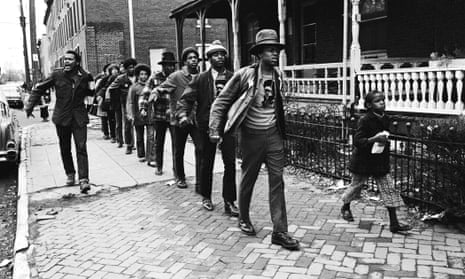When the Black Panthers came to west Philadelphia, their boldness and courage struck a chord with my friends and me. They handed out papers with graphic depictions of black men and women standing up for themselves and demanding freedom. I was 17, and I’d never seen anything like it.
I grew up in a predominantly black community of working-class people. Many were children or grandchildren of people who had migrated from the south. Before I joined the Black Panther party, I’d failed school. I was working hard at doing all the wrong things. Getting involved with the party led me in a new direction.
My first step was going to a political education class. I listened to people explain racism and white supremacy, capitalism and imperialism. They talked about why my neighbourhood looked one way whereas others looked another way. My friends and I had discussed these things,but this put them in context.
In this photograph, I’m at the front by chance: I wasn’t in any position of leadership. We often did marches through the community. It was a way for us to learn to work together. We tried to educate ourselves and other young people that it wasn’t in our best interests to have internal fights – it didn’t promote unity. Young kids liked to be part of the drills, because it was fun. We would sing and chant, calling for the end of the Vietnam war or the release of political prisoners.
There are stereotypes of the Black Panthers as people who ran around with guns, fighting the police day and night, but that’s far from the truth. We spent most days doing voluntary and advocacy work. We served free breakfasts to children, worked with seniors, had a free medical clinic. At weekends, we ran “liberation schools” where we taught the history of black people. We’d present young people with more possibilities than they were given at public school.
There was no such thing as a part-time revolutionary, and I worked for the party full-time for two years. I’ve remained involved in politics for the rest of my life. Four years ago I founded an independent black political party, the New Afrikan Independence party. The issues I’m involved in now include police and community violence. And I still fight for political prisoners.
We have communication and mobilisation tools at our fingertips now that we couldn’t have imagined 50 years ago. Back then, we’d use mimeograph machines that would get ink all over our shirts and hands. We’d print 500 flyers, then run around passing them out. The sophistication of technology accounts for the current spotlight on police brutality and terror. That didn’t stop in the 70s. And it hasn’t stopped today.
I’m 63 now. I have six kids and they’re all politically conscious, especially the older ones. When I look at myself here, I see someone who was willing to take a risk and stand up for the things he thought were right. I’m extremely proud to have been part of a party that helped shape radical thought in the United States among black people and other people of colour.
Power To The People: The World Of The Black Panthers, by Bobby Seale and photographer Stephen Shames, is published by Abrams Books at £25.
Are you in a notable photograph? Email thatsme@theguardian.com.

Comments (…)
Sign in or create your Guardian account to join the discussion